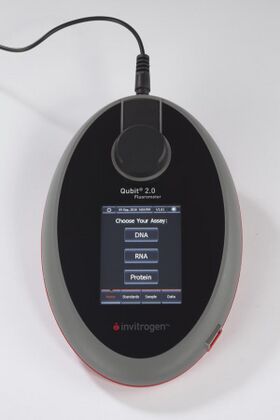Physics:Qubit fluorometer

The Qubit fluorometer is a laboratory instrument developed and distributed by Invitrogen, which is now a part of Thermo Fisher. It is used for the quantification of DNA, RNA, and protein.[1][2][3][4]
Method
The Qubit fluorometer method is to use fluorescent dyes to determine the concentration of either nucleic acids or proteins in a sample. Specialized fluorescent dyes bind specifically to the substances of interest. A spectrophotometer is used in this method to measure the natural absorbance of light at 260 nm (for DNA and RNA) or 280 nm (for proteins).[5][6][7][8]
Fluorescent dyes
The Qubit assays (formerly known as Quant-iT) were previously developed and manufactured by Molecular Probes (now part of Life Technologies). Each dye is specialized for one type of molecule (DNA, RNA, or protein). These dyes exhibit extremely low fluorescence until bound to their target molecule. Upon binding to DNA, the dye molecules assume a more rigid shape and increase in fluorescence by several orders of magnitude, most likely due to intercalation between the bases.[9][10]
The Qubit fluorometer, a device designed to measure fluorescence signals from samples, operates by correlating these signals with known concentrations of probes. This process enables it to transform the fluorescence data into a quantified concentration measurement. The device uses this established relationship to accurately determine the concentration of a sample.
A specific instance of this technology is the Qubit 2.0 fluorometer, which is often used in conjunction with the "dsDNA BR Assay Kit." This kit, along with others in the Qubit quantification system, incorporates dyes. These dyes are sensitive to different biomolecules and their concentrations. In this context, "ds" denotes double-stranded and "ss" signifies single-stranded DNA, indicating the specific types of DNA that the dyes can detect.
| Reagent/Assay | Assay range | Sample starting concentration range |
|---|---|---|
| Qubit dsDNA HS Assay | 0.2–100 ng | 10 pg/μl–100 ng/μl |
| Qubit dsDNA BR Assay | 2–1,000 ng | 100 pg/μl–1 μg/μl |
| Qubit ssDNA Assay | 1-200 ng | 50 pg/µL-200 ng/µL |
| Qubit RNA Assay | 5–100 ng | 250 pg/μl–100 ng/μl |
| Qubit RNA BR Assay | 20–1,000 ng | 1 ng/µ-1 µg/µL |
| Qubit Protein Assay* | 0.25–5 μg | 12.5 μg/ml–5 mg/ml |
Versions
The second generation, the Qubit 2.0 Fluorometer, was released in 2010, and the 3rd generation as Qubit 3.0 in 2014. The newest version is the 4th generation Qubit 4, introduced in 2017.
References
- ↑ "Optimization and validation studies of the MentypeR Argus X-8 kit for paternity cases.". Forensic Sci Int Genet Suppl 2: 47–48. 2009. doi:10.1016/j.fsigss.2009.08.189.
- ↑ "Enriched environment influences hormonal status and hippocampal brain derived neurotrophic factor in a sex dependent manner". Neuroscience 164 (2): 788–797. 2009. doi:10.1016/j.neuroscience.2009.08.054. PMID 19723563.
- ↑ "A new real time PCR-based assay for diagnosing Renibacterium salmoninarum in rainbow trout (Oncorhynchus mykiss) and comparison with other techniques". J Microbiol Methods 76 (1): 75–80. 2009. doi:10.1016/j.mimet.2008.09.014. PMID 18938198.
- ↑ "Detection and quantification of human bocavirus in riverwater". J Gen Virol 90 (Pt 11): 2634–2637. 2009. doi:10.1099/vir.0.013557-0. PMID 19656966.
- ↑ Manchester, K.L. (1996). "Use of UV methods for the measurement of protein and nucleic acid concentrations". BioTechniques 20 (6): 968–970. doi:10.2144/96206bm05. PMID 8780864.
- ↑ Glasel, J.A. (1995). "Validity of nucleic acid purities monitored by 260 nm/280 nm absorbance ratios". BioTechniques 18 (1): 62–63. PMID 7702855.
- ↑ Huberman, J.A. (1995). "Importance of measuring nucleic acid absorbance at 240 nm as well as at 260 and 280 nm". BioTechniques 18 (4): 636. PMID 7598897.
- ↑ Manchester, K.L. (1995). "Value of A260/A280 ratios for measurement of purity of nucleic acids". BioTechniques 19 (2): 208–210. PMID 8527139.
- ↑ McKnight, R.E., Gleason, A.B., Keyes, J.A., Sahabi, S. (2006). "Binding mode and affinity studies of DNA-binding agents using topoisomerase I DNA unwinding assay". Bioorganic & Medicinal Chemistry Letters 17 (4): 1013–1017. doi:10.1016/j.bmcl.2006.11.038. PMID 17157016.
- ↑ Schweitzer, C.; Scaiano, J. C. (2003). "Selective binding and local photophysics of the fluorescent cyanine dye PicoGreen in double-stranded and single-stranded DNA". Physical Chemistry Chemical Physics 5 (21): 4911–4917. doi:10.1039/b305921a. Bibcode: 2003PCCP....5.4911S.
External links
 |

